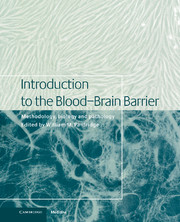Book contents
- Frontmatter
- Contents
- List of contributors
- 1 Blood–brain barrier methodology and biology
- Part I Methodology
- Part II Transport biology
- 18 Biology of the blood–brain glucose transporter
- 19 Glucose transporters in mammalian brain development
- 20 Blood–brain barrier amino acid transport
- 21 P-glycoprotein, a guardian of the brain
- 22 Blood–brain barrier ion transport
- 23 Ion channels in endothelial cells
- 24 Interactions of lipoproteins with the blood–brain barrier
- 25 Fatty acid and lipid intermediate transport
- 26 Blood–brain barrier transport of drugs
- Part III General aspects of CNS transport
- Part IV Signal transduction/biochemical aspects
- Part V Pathophysiology in disease states
- Index
22 - Blood–brain barrier ion transport
from Part II - Transport biology
Published online by Cambridge University Press: 10 December 2009
- Frontmatter
- Contents
- List of contributors
- 1 Blood–brain barrier methodology and biology
- Part I Methodology
- Part II Transport biology
- 18 Biology of the blood–brain glucose transporter
- 19 Glucose transporters in mammalian brain development
- 20 Blood–brain barrier amino acid transport
- 21 P-glycoprotein, a guardian of the brain
- 22 Blood–brain barrier ion transport
- 23 Ion channels in endothelial cells
- 24 Interactions of lipoproteins with the blood–brain barrier
- 25 Fatty acid and lipid intermediate transport
- 26 Blood–brain barrier transport of drugs
- Part III General aspects of CNS transport
- Part IV Signal transduction/biochemical aspects
- Part V Pathophysiology in disease states
- Index
Summary
Introduction
The blood–brain barrier (BBB), formed by the cerebral endothelial cells and their connecting tight junctions, has a very low permeability to ions unless specific transporters are present. The endothelial movement of ions, via either ion transporters or ion channels, has a number of important functions. It is involved in the regulation of several key ion concentrations in the brain (e.g. K+, Ca2+, H+), the uptake and extrusion of trace metals, fluid secretion and, by linkage to the endothelial sodium gradient, nutrient transport. Ion transport is also important in regulating BBB function. For example, changes in endothelial cell [Ca2+] and volume modulate BBB integrity (Rapoport et al., 1980; Olesen and Crone, 1986).
Understanding ion transport at the BBB may aid in the treatment of a number of disease states, particularly those such as stroke where edema formation results from a net accumulation of ions and thus water in the brain (Betz et al., 1994). However, despite the importance of BBB ion transport in normal and pathophysiological conditions and its potential for modulating BBB function, our knowledge of ion transport and its regulation is still far from complete. This particularly reflects the limitations of in vivo BBB experimentation and deficiencies in current in vitro preparations. Although such difficulties apply to all studies of the BBB, they are particularly pertinent to ion transport because of the low rate of transport.
- Type
- Chapter
- Information
- Introduction to the Blood-Brain BarrierMethodology, Biology and Pathology, pp. 207 - 213Publisher: Cambridge University PressPrint publication year: 1998
- 7
- Cited by

